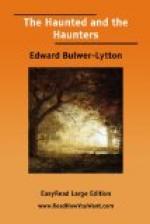Among later tales ought to be reckoned Edith Wharton’s Tales of Men and Ghosts, and Henry James’s The Two Magics, whose “Turn of the Screw” gives us new instances of the evil genii that haunt mortals, in this case two innocent children. One remembers sundry folk-tales with the same motive—of children bewitched or forespoken—inspiring them. And an old charm in Orkney which used to run:
“Father, Son, Holy Ghost!
Bitten sall they be,
Bairn, wha have bitten thee!
Care to their black vein,
Till thou hast thy health
again!
Mend thou in God’s name!”
John Aubrey in his Miscellanies has many naive evidences of the twilight region of consciousness, like that between wake and sleep, which tends to fade when we are wideawake; so much so, that we call it visionary. Yet it is very real to the haunted folk, to Aubrey’s correspondent, the Rector of Chedzoy, or to the false love of the Demon Lover, or that Mr Bourne of whom Glanvil tells in The Iron Chest of Durley, or the Bishop Evodius who was St Augustine’s friend, or for that matter the son of Monica himself. The reality of these visitations may seem dim, but the most sceptical of us cannot doubt that, whether from some quickened fear of death or impending disaster, from evil conscience or swift intensification of vision; whether in the forms of beloved sons lost at sea or of other revenants who were held indispensably dear in life, the haunters have appeared, to the absolute belief of those who saw them or their simulacra.
“It poseth me,” said Richard Baxter, “to think of what kind these visitants are. Do good spirits dwell then so near us, or are they sent on such messages?” The question, indeed, poseth most of us, but we cannot leave the inquiry alone. M. Larigot, realising this preoccupation, has in the course of his investigations, during many years, arrived at the conclusion that there is an Art of the Supernatural,




